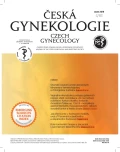A rare complication of long-term vaginal prolapse
Authors:
O. Novák 2; P. Vašek 1; M. Gärtner 1; J. Krhut 3
Authors‘ workplace:
Gynekologicko-porodnická klinika FN, Ostrava, přednosta doc. MUDr. O. Šimetka, Ph. D., MBA
1; Gynekologicko porodnické oddělení nemocnice Nový Jičín, primář MUDr. P. Bartoš, Ph. D., MMED
2; Urologická klinika FN, Ostrava, přednosta doc. MUDr. J. Krhut, Ph. D.
3
Published in:
Ceska Gynekol 2018; 83(4): 271-275
Category:
Case Report
Overview
Objective: Description of rare complication of long-term uterine prolaps.
Desing: Case report.
Setting: Department of Obstetric and Gynecology, University Hospital Ostrava.
Case report: A seventy-years-old pacient with longterm complete uterine prolaps underwent vaginal hysterectomy with colpoclesis at department of Obstetric and Gynecology of university hospital Ostrava in August 2017. The surgery was planned more than year ago, when patient had no symptoms. But due to patient‘s injury, it was postponed and the condition was already complicated by urine incontinency. The surgery was complicated by bladder lesion, because it was suggested as a pelvis tumor. Correction of cystolithiasis was planned at a second time, when suprapubic cystolithotomy was performed after 16 days. Temporary urinary derivation was ensured by bilateral nephrostomy, epicystostomy and urinal catetrization for low residual bladder capacity after surgery.
Conclusion: Bladder stones are a rare complication of otherwise relatively frequent complete urogenital prolaps in women. Major causes include micturition disorder and chronic urinary tract infection which is caused by vaginal and uterus descensus.
Keywords: long-term vaginal prolapse, bladder lesion, rare complication
Sources
1. Agarwal, MM., Singh, SK., Mavuduru, R., et al. Preventive fluid and dietary therapy for urolithiasis: An appraisal of strength, controversies and lacunae of current literature. Indian J Urol IJU J Urol Soc India, 2011, 27, p. 310–319.
2. Agarwal, N., Kriplani, A., Bhatla, N., et al. Management of genital prolapse with huge vesical calculi. J Gynecol Surg, 2007, 23, p. 121–124.
3. Alelign, T., Petros, B. Kidney stone disease: an update on current concepts. Adv. Urol. 2018; Dostupné: https://www.ncbi.nlm.nih.gov/pmc/articles/PMC5817324/.
4. Barber, MD. Pelvic organ prolapse. BMJ, 2016; i3853 doi.
5. Basler, J., Leon-Becerril, J.A. Bladder stones treatment & management: approach considerations, pharmacologic stone dissolution, surgical fragmentation and removal, 2017. Dostupné: https://emedicine.medscape.com/article/2120102-treatment.
6. Basnet, P., Agrawal, A., Thakur, AK., et al. Multiple vesical calculi complicating uterine prolapsed. Health Renaissance, 2015, 12.
7. Bureau, M., Carlson, KV. Pelvic organ prolapse: A primer for urologists. Can Urol Assoc J, 2017, 11, p. 125–130.
8. Cardozo, L., Staskin, D. Textbook of female urology and urogynecology, fourth ed. CRC Press, 2017, 3284 p.
9. Dalela, D., Agarwal, R. Large vesical calculus in a cystocoele: an uncommon cause of irreducible genital prolapse. BJU Int, 1999, 84, p. 171–172.
10. Dvořáček, J. Urologie: obecná a speciální urologie. Praha: Karolinum, 1999, 235 s.
11. Halaška, M., et al. Urogynekologie. 1. ed., Galén, 2004, 256 s.
12. Härkki-Sirén, P., Sjöberg, J., Tiitinen, A. Urinary tract injuries after hysterectomy. Obstet Gynecol, 1998, 92, p. 113–118.
13. Haylen, BT., Maher, CF., Barber, MD., et al. Erratum to: An International Urogynecological Association (IUGA) / International Continence Society (ICS) joint report on the terminology for female pelvic organ prolapse (POP). Int Urogynecology J, 2016, 27, p. 655–684.
14. Kang, L-M., Liu, C-H., Huang, Cl. Uterine prolapse results in vesical stones, ureteral stone, and acute renal failure: a case report. J Urol ROC, 2000, 11, p. 190–192.
15. Kudela, M., Ondrová, D., Hejtmánek, P. Etiopatogeneze prolapsu pochvy po hysterektomii. Čes Gynek, 2006, s. 329-332.
16. Leslie, SW., Bhimji, SS. Bladder, stones, in statPearls. StatPearls Publishing: Treasure Island (FL), 2017. Dostupné: http://www.ncbi.nlm.nih.gov/books/NBK441944/.
17. Michalec, I., Tomanová, M., Navrátilová, M., et al. Rizikové faktory poškození svalů pánevního dna v souvislosti s vaginálním porodem. Čes Gynek, 2015, s. 11–15.
18. Rajmon, P. Urolitiáza – léčba podle lokalizace kamene. Urol Praxi, 2001, s. 188–190.
19. Rani Saha, M., Kumer Saha, T., et al. Uterovaginal prolapse with multiple vesical calculi: A rare case report. J Dhaka Med Coll, 2017, 25, p. 77.
20. Rege, SA., Nunes, QM., Dalvi, AN. Giant vesical calculus. Bombay Hosp J, 2001, p. 582–583.
21. Rovný, A., Kumstát, P., Šabacký, I. Dlouhodobé derivace moči – principy provedení. Urol Praxi, 2003, s. 69–73.
22. Shashidhar, B., Shetty, K. Uterovaginal prolapse with giant vesical calculus: a rare case report. Ind J Clinic Pract, 2013, 12, p. 837–839.
23. Wai, CY., Margulis, V., Baugh, BR., Schaffer, JI. Multiple vesical calculi and complete vaginal vault prolapse. Am J Obstet Gynecol, 2003, 189, p. 884–885.
24. Záleský, M., Zachoval, R., Vik, V., et al. Urologické konsekvence gynekologických operací. Urol Listy, 2008, 1, s. 78–84.
25. Zeman, M., Krška, Z., et al. Chirurgická propedeutika, třetí vyd. Praha: Grada, 2011, 512 s.
Labels
Paediatric gynaecology Gynaecology and obstetrics Reproduction medicineArticle was published in
Czech Gynaecology

2018 Issue 4
Most read in this issue
- Late morbidity in cesarean section scar syndrome
- Implantation and diagnostics of endometrial receptivity
- Zoon vulvitis – a rare form of chronic inflammation of the vulva
- Possibilities and real meaning of assessment of ovarian reserve
